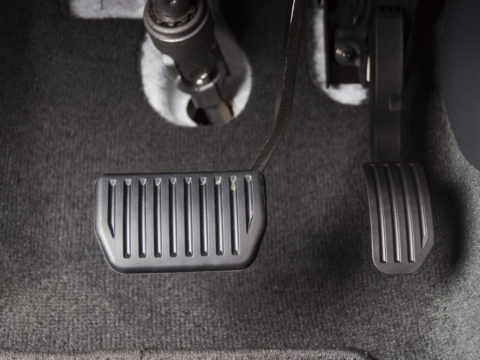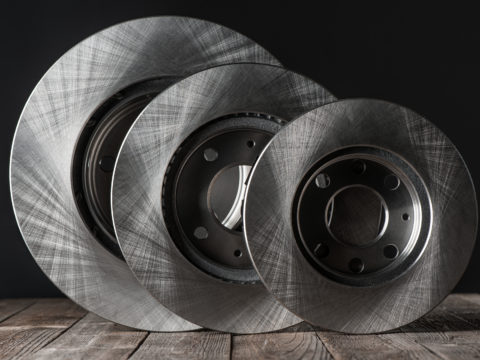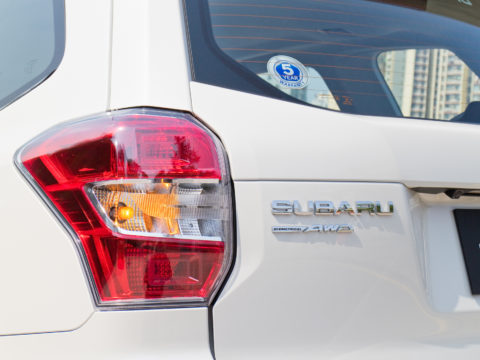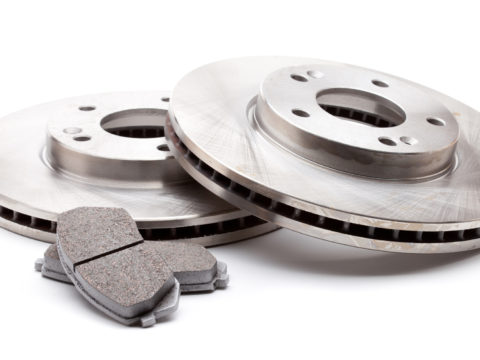Your car’s brakes are an essential feature of your vehicle, especially for safety. Among other issues, brake caliper sticking is something all drivers may face at some point, which is why it helps to know the symptoms, causes, and how to fix your brake caliper if needed.
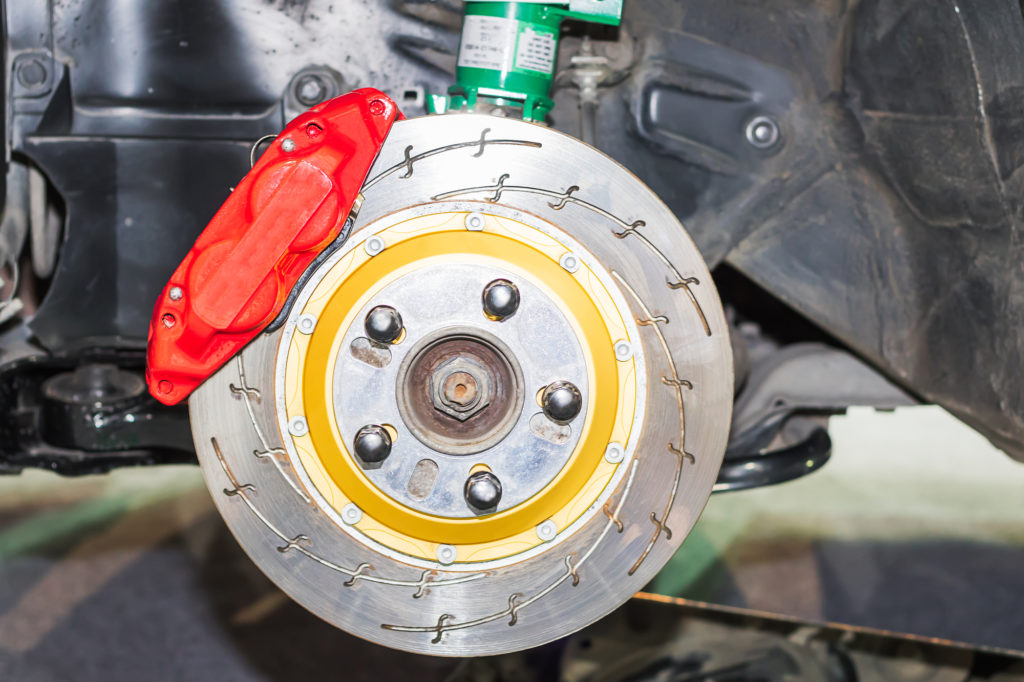
Contents
What Is a Brake Caliper?
Most modern vehicles have a braking system that features a caliper, rotor, and pad. One of each sits at each of the four corners of the vehicle. They all work together to slow the vehicle when you depress the brake pedal. You can usually see the brake caliper by looking through the wheels. In this video about painting a brake caliper, you can get a perfect look at one.
Some vehicles have drum brakes, so to be clear, that is an entirely different system.
How Does the Brake Caliper Work?
Think of a brake caliper as a big, strong clamp. When you press the brake pedal, the caliper squeezes the brake pads against the brake rotor, slowing the rotation of the hub. The friction creates a tremendous amount of heat, so brake systems have to be pretty rugged to stand up to the rigors of everyday driving, let alone hard stops.
What Does It Mean By Brake Calipers Sticking?
When someone says that their brake calipers are sticking, it usually means that they’re feeling a sensation of the brake releasing too slowly. Since the caliper and the rest of the braking system work so hard and get extremely hot, this is an issue to check out right away.
How to Tell if Brake Caliper Is Sticking?
There are a few tell-tale symptoms that a brake caliper is sticking or releasing too slowly. The most obvious sign of a braking issue would be a warning light on your dashboard, but that might just be a general warning light for the brake system. So, keep alert for the following specific signs of a sticky brake caliper.
a) Brake Pedal Rises Slowly
After you depress the brake pedal to slow the car, you’ll take your foot off of it to release the brakes. If the caliper is sticking, the pedal may not come back up right away, and this delay in the return is a sign that you might have a sticky caliper.
b) The Car Pulls to One Side
If you press the brakes, it shouldn’t affect your direction of travel. But if there is a problem with the system, like a sticking caliper, you may notice that the car pulls to the left or the right a bit right after braking.
Since this sort of unintended change in direction can be pretty dangerous, you should investigate the issue as soon as possible.
c) Increased Stopping Distance
If you’re pressing the brakes and it seems like the car isn’t stopping as well as it should, it could be a sign of sticking brake rotors. That’s because a brake rotor that sticks might be a sign of another issue with your braking system, like low or leaking fluid.
d) Burning Smells
Burning brakes have a distinct smell. You might catch an occasional whiff of burning brake material after driving your car very hard or when you’re near a big truck descending a steep hill on the highway.
If you can detect an odor of burning brakes, you might have a stuck or sticky caliper. Since it’s squeezing the pad into the rotor more than it should, it will get much hotter than normal, and you may smell the evidence.
e) Leaking Brake Fluid
If you detect a brake fluid leak, you need to check it out immediately. Driving without enough fluid can cause your brakes not to work, which is obviously quite dangerous, and it might also lead to sticky brake calipers.
f) Significant Heat Around a Wheel
We all know that cars can get pretty hot, especially after a long hard drive. But if you’re noticing that there is more heat than usual coming off one or more wheels, you might have a stuck brake caliper.
g) Unusual Sounds
When some people hear an odd noise coming from their car, they just turn up the radio and pretend it isn’t there. That’s not a smart move because screeching, squealing, and grinding noises from the brakes could be a sign of a sticking caliper or another major issue.
Main Causes of Brake Caliper Sticking
There are quite a few reasons why a brake caliper might be sticking. These are the main causes.
a) Worn-Out Brake Fluid
If your brake fluid is old, dirty, or just worn out, your calipers may stick a bit. Brake fluid should be replaced every couple of years on a car with regular wear and tear. But if you’re a spirited driver, or you often drive with a heavy load on your vehicle, you might want to replace the fluid much sooner.
b) Leaking Brake Line
Brake lines also wear out, which could mean that they develop little bulges or even a leak. Little bulges might not seem like a big deal, but when the brake lines give too much extra room for the pressurized brake fluid to move around, it affects the way the pedal will feel under your foot.
When brake lines start to leak, you might experience sticky calipers. An even bigger risk is that the car might not stop as well as you need it to. So make sure to replace your brake lines at the first sign of wear or leaks.
c) Stuck Handbrake Cable
If your sticky brake caliper is at the rear of the car, you might have an issue with the handbrake. Also known as the emergency or parking brake, this system relies on a mechanism on the brake caliper that secures the vehicle against rolling when you activate it from the cabin.
If the emergency brake cable and mechanism is worn, dirty, rusty, or corroded, it might not smoothly release when you deactivate it. That might lead to one or both calipers feeling sticky at the rear of the vehicle.
d) Dirty Brake Guide Pin
A dirty brake caliper guide pin is a very specific issue that can easily lead to a sticky brake pad. The caliper slides along the guide pins during braking action, and the caliper should move smoothly in response to your pressing and releasing the brake pedal. When the guide pins get dirty, they can cause erratic braking, like sticky calipers.
Guide pins typically come from the factory wearing a protective rubber covering or boot. Some DIY mechanics tend to break the rubber boots, as they discount the need for them, and they’re easy to tear. Then, a few thousand miles later, the guide pins have lost all their lubrication and collected debris and dirt that inhibits the smooth movement of the caliper.
You can fix this by cleaning and then lubricating the guide pins and working the caliper back and forth to ensure it moves smoothly.
e) Rust
Rust is a major problem with braking systems. Brakes have steel parts that live underneath the car where they are exposed to rain, debris, and road salt. When the calipers become rusty, their pistons, bolts, and other mechanisms don’t move smoothly. And that can all lead to sticking brake calipers.
If the rust gets too bad, the components may even fail, requiring replacement instead of just a repair.
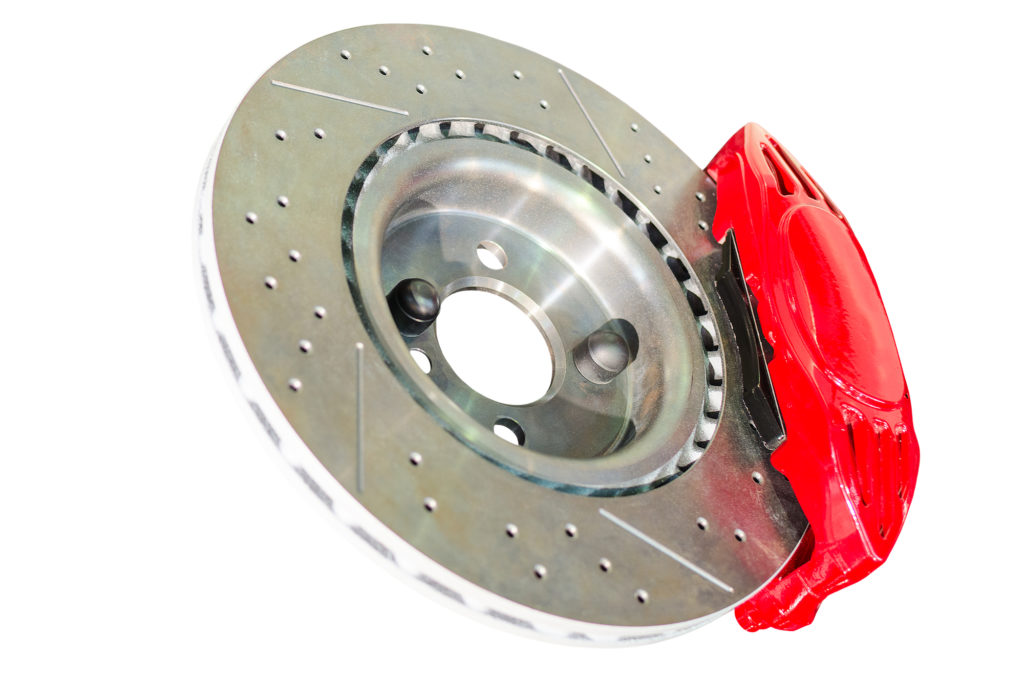
How to Fix a Seized Brake Caliper
A sticking or stuck brake caliper needs urgent repair. Here’s a quick step-by-step guide. Remember to always use best safety practices and if you’re not comfortable working under a car, go to a professional mechanic.
1. Raise the Vehicle
If you know which caliper is sticking, start there. Always activate the emergency brake and place chocks on the wheels that will stay on the ground. Then use a jack to lift the vehicle at the corner where you will be working. Some jacks allow you to lift one whole end of the car, so always follow the instructions.
Never work under a car that’s only supported by a jack. Use jack stands and cribbing to secure the vehicle before you slide under it.
2. Remove the Wheel
Now that the vehicle has been safely raised, you can remove the wheel in question. Use a lug wrench or impact driver to loosen the bolts. Remove each of the bolts and secure them from rolling away. Now you can remove the wheel. If it’s stuck, try banging one edge of the tire with your hand to unstick it from the hub. Set the wheel aside.
3. Clean the Pads
You can clean much of the pads before you remove them, and it’s a good practice to do so, as it will make removal easier. Use a commercial brake cleaner and spray it on the exposed parts of the pads and their lining according to the instructions on the bottle. Wipe everything down with a rag. You can then remove the pads and clean them again.
4. Clean and Inspect the Caliper
Now, move on to cleaning the brake caliper the same way you cleaned the pads. While you’re working, look for any damaged rubber boots or points with obvious discoloration or signs of leaking brake fluid. You can loosen the bolts in the caliper if you need to or even remove it completely.
You really want to clean everything thoroughly. Afterward, cycle the brakes a few times, and look for leaks. Sometimes, you can repair leaks or replace damaged rubber components without removing the caliper. If things are in terrible shape, you may need to replace some parts or even the caliper itself.
5. Lubricate the Caliper
After everything is thoroughly cleaned, you’ll want to reapply lubricant. Make sure to use a lubricant that’s safe for your car’s braking system. Coat the slides, pins, bolts, and pistons to ensure they slide smoothly. You may be able to work the brake caliper a bit with your hands, or you can cycle the caliper a few times by hopping in the car and pressing the pedal a few times.
6. Button Up
Now you can put the caliper back in place and then do the same with the brake pads. Finally, put your wheel back on. Always follow the manufacturer’s torquing recommendations. You don’t want bolts to be too loose or too tight. Lastly, you can go for a test drive and make sure you have fixed the issue.
Why You Should Not Drive With a Stuck Brake Caliper
A stuck brake caliper can be quite dangerous. It’s not advisable to drive with this sort of issue.
● Gas Wastage
Driving with a stuck or sticky brake caliper results in the brakes slowing the car down, even when you’re trying to speed up. As you might imagine, this makes the engine work harder, and in turn, uses more fuel than should be necessary to get you where you’re going.
That’s wasteful in terms of your fuel economy, so instead of wasting gasoline or diesel fuel, get your brakes inspected and repaired.
● Parts Wearing Out
When the brake caliper sticks, the pads, and the rotors are working even when you’re not intentionally slowing down. That means that all the parts of the brakes are under extreme friction unnecessarily, accelerating their wear and shortening their life.
● Bearings Overheating
When the brakes remain applied unnecessarily, they don’t get a chance to cool off. In normal conditions, the brake system works hard and gets very hot while you’re slowing down but then has ample time to cool down when you release the pedal.
Since your caliper sticks, the heat never gets a chance to dissipate, and that can burn up the bearings and other parts quickly. It could even lead to a fire.
● Poor Brake Performance May Lead to Accidents
Brake problems are a leading cause of large truck crashes. But sticking brake calipers can easily lead to an accident in a passenger car as well. When you hit the brakes, you need them to work reliably and predictably, or you’re putting yourself at an increased risk of crashing.
The Cost of Repairing Sticking Brake Calipers
If you have the ability to work on your car yourself, and you have some brake cleaner and a rag in your garage, it might not cost you anything but some time to clean up and lubricate your brake calipers. If you have to pay for a professional to repair sticking brake calipers, you will probably end up paying a few hundred dollars.
If you need to replace parts, things might get expensive pretty fast. But the cost of a brake repair pales in comparison to the risk of damaging your vehicle or being in an accident because of a sticky brake caliper.

